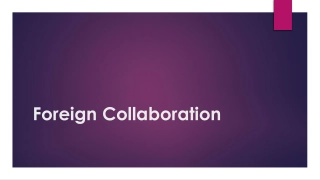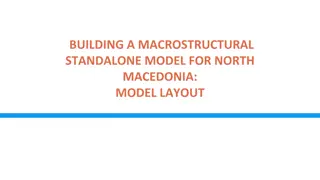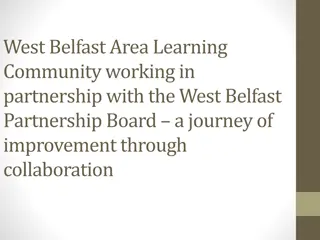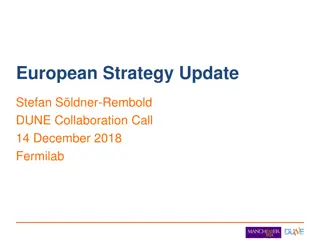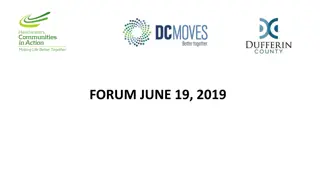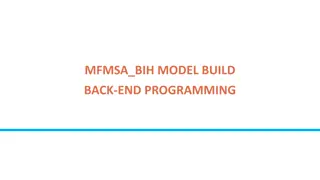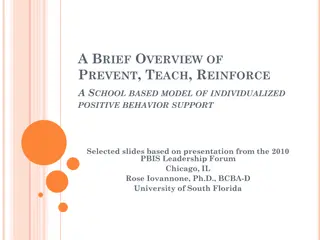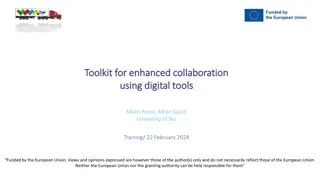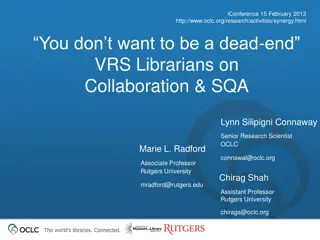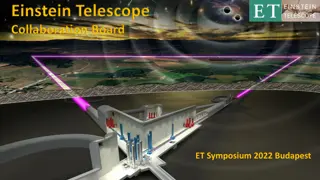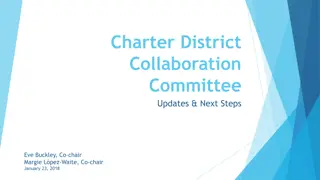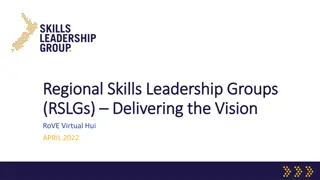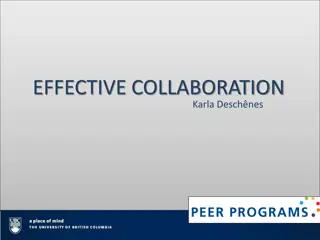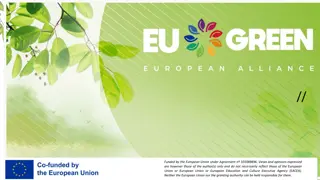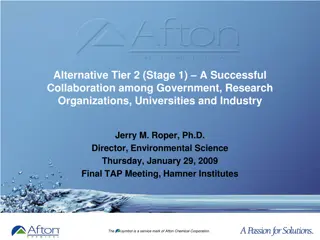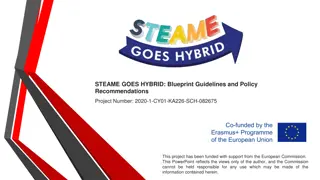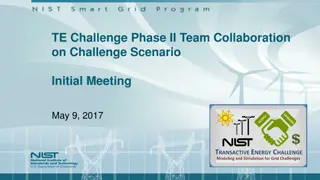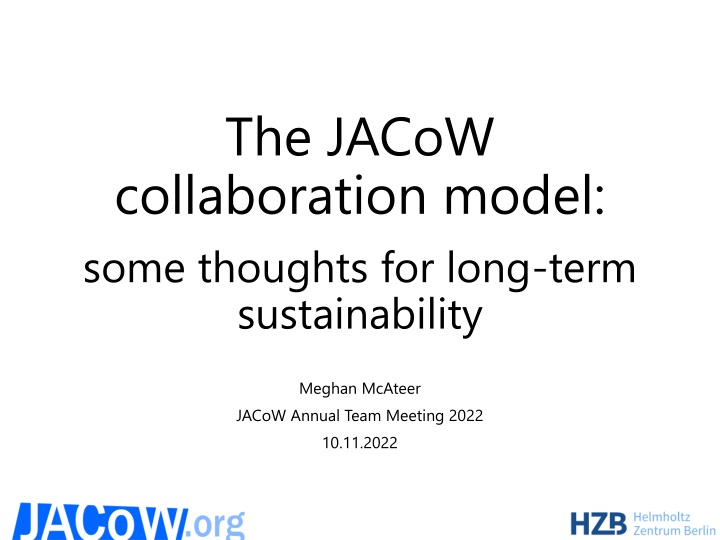
Maximizing Efficiency in JACoW Collaboration Model
Explore the functioning and challenges of the JACoW collaboration model, focusing on improving agreements for long-term sustainability. Learn about the purpose, team composition, and intentions behind the current agreements, along with potential pitfalls and areas for enhancement. Discover how representatives from various conferences interact within the JACoW team and the strategies for ensuring continuity and knowledge transfer. Enhance your understanding of the collaborative efforts in publishing proceedings and providing essential tools and training for conferences.
Uploaded on | 0 Views
Download Presentation

Please find below an Image/Link to download the presentation.
The content on the website is provided AS IS for your information and personal use only. It may not be sold, licensed, or shared on other websites without obtaining consent from the author. If you encounter any issues during the download, it is possible that the publisher has removed the file from their server.
You are allowed to download the files provided on this website for personal or commercial use, subject to the condition that they are used lawfully. All files are the property of their respective owners.
The content on the website is provided AS IS for your information and personal use only. It may not be sold, licensed, or shared on other websites without obtaining consent from the author.
E N D
Presentation Transcript
The JACoW collaboration model: . some thoughts for long-term sustainability Meghan McAteer JACoW Annual Team Meeting 2022 10.11.2022
How does the JACoW collaboration model work? What are the agreements that define how representatives from each conference interact with the rest of the JACoW team? How could these agreements be improved? Whatever our collaboration agreements are, they must be supported by everyone involved! (Organizing Committees, core JACoW team, ) Note: these slides have been slightly modified from the version presented at JTM 22 based on feedback received
JACoW Collaboration Model The purpose of the JACoW collaboration is to publish and provide archival storage of proceedigs, and to provide training, tools, and infrastructure to enable conferences to produce their own proceedings. The JACoW Team is composed of: 1. Long-term members: people who manage infrastructure and services, people who develop and maintain tools, co- opted editors, experts in various topics, 2. Rolling members: editors-in-chief from each conference who join the team for three years and are responsible for editing the proceedings for their conference with support from the rest of the JACoW team (each conference must agree to attend team meetings for three years as part of the conditions for using SPMS)
Intention of Current Agreements A representative from each individual conference is a part of the JACoW team for three years This allows them to learn best practices and profit from the experience of the previous conference instance, produce their proceedings, and then transfer the knowledge gained to a representative of the next conference in the series The JACoW agreement requires that representatives of each event attend three team meetings, and typically they will also join the editorial team of another event to gain hands-on experience This arrangement is meant to ensure continuity among each conference series and to give representatives from each conference access to the training they need to produce proceedings
Pitfalls of Current Agreements (particularly for non-IPAC events) Most conference series occur biennially or less often, so transfer of knowledge between events in a series via attendance at three team meetings doesn t always work smoothly Average of 10 JACoW conferences per year -> approx. 30 rolling team members obligated to attend the team meeting each year (unnecessary/excessive amount of travel overall, and neither adhered to nor enforced) Financial burden of obligations to send editors to three team meetings can be particularly unmanageable and disproportionate for small institutions hosting small workshops If institute representatives don t engage in necessary training as described in agreements, burden of producing proceedings falls instead on a small number of core JACoW team members
Interjection: Number of papers in proceedings volumes The scale of IPAC proceedings is entirely different from all other JACoW conference series; discussion that follows is (for now) *only* intended for non-IPAC events Editing all non-IPAC proceedings requires (very roughly) 40 person*conferences of editor time per year; we need a large enough pool of trained editors to do this work * See appendix for details of how this estimate was reached
Suggestion: (only for non-IPAC conferences) Eliminate 3-year rolling membership concept Instead, each conference series provides a person who will join the JACoW team and take long-term (maybe 5 years?) responsibility as editor-in-chief for that conference series (In the case of non-annual conferences, two series could coordinate and have a single editor-in-chief take responsibility for both)
Benefits of this approach Significant overall cost reductions Less time and money spend training new editors for every conference Fewer people obligated to attend annual collaboration meeting (10-15 each year rather than 30 per year) Editorial teams can be smaller when conference representatives are more experienced Continuity within a conference series is built in; knowledge transfer no longer an annual problem Conference series representative becomes more integrated within the JACoW team and more able to contribute to sustaining and developing the collaboration
Benefits of this approach Rough estimate of costs associated with editorial personnel for a typical small conference (~80 papers), if following all agreements and typical best practices: Old scheme (per conference instance): Attendance at three team meetings Support for team of ~4 or 5 editors A total of about 8 to 10 person-weeks of labor time 3 weeks at team meetings 1 or 2 weeks for training new editors at other conferences, 4 or 5 weeks for editing conference proceedings For smaller conferences, costs associated with training and supporting editors might be reduced by well over 50% New scheme (per conference instance): Attendance at one team meeting Support for team of ~3 editors A total of 4 or 5 person-weeks of labor time: 1 week at team meetings 1 week for training a new editor (maybe) 3 weeks for editing conference proceedings
Summary & Comments Some change to the collaboration model is essential the current system isn t sustainable in the long term Suggested idea is to replace the 3-year rolling membership in the JACoW team (for each individual conference) model with a longer-term representative for each conference series (this suggestion is currently intended for non-IPAC conferences IPAC is an endeavor of a different scale and needs separate consideration) This approach would require more effort and involvement from conference series organizers, but in return, overall costs associated with JACoW personnel would decrease considerably This idea (like any other collaboration model) would only work if enough stakeholders actively support it!
Comments? Questions?
Appendix: Some rough estimates about the amount of labor that goes into editing proceedings (maybe underestimating in some cases)
How many editors does it take to produce a proceedings volume? Approx 40-45 papers per editor is a reasonable estimate, based on IPACs (including novice editors; rate for experienced editors is probably higher)
How many editors does it take to produce a proceedings volume? Smaller conferences have proportionally many more editors than larger conferences have. Is this avoidable? Notes: In the top plot, orange line is (1 editor per 45 papers) +1 (because often, at least one person on editorial team is occupied with other tasks) In the bottom plot, number of papers per editor is calculated assuming that one member of editorial team is occupied with other tasks and so not editing many papers *incomplete data for conferences since 2016 is shown
A closer look at number of papers and number of editors (excluding IPAC) Assumptions for estimating number of editors needed for non-IPAC conferences: 45 papers per editor One additional editorial team member (whose time may be occupied with other tasks) ?? 45 -> ??= ???? + 1 -> For nearly half of the conference series, the average number of papers in proceedings is well under 100 and editing typically could be handled by a team of three or fewer (experienced) editors! *Note: generating a proceedings volume involves additional labor beyond the editing of papers, so the count of number of editors involved and number of editors needed is slightly ambiguous
Comparison of actual and (estimated) minimal needed number of editors
Overview of non-IPAC conferences Annual Even Years* Every 3 years Odd Years* Avg # papers (since 2016) 137 340 59 229 31 268 83 50 179 28 115 50 177 105 62 40 322 44 56 Avg # editors needed 5 9 3 7 2 7 3 3 5 2 4 3 5 4 3 2 9 1 3 Avg # editors per year 5 4.5 1.5 3.5 1 3.5 1.5 1.5 2.5 1 2 1.5 2.5 1.5 1 1 3 1 1 40 *schedule may be inaccurate due to recent skipped years IBIC ICALEPCS PCaPAC SRF ERL LINAC HB eeFACT FEL COOL MEDSI ECRIS RuPAC (?) Cyclotrons ICAP HIAT NA-PAC ABDW FLS SAP Total On average, (very) roughly 40 person-conferences of editor labor are needed per year *excluding* IPAC (Overall, the collaboration needs enough trained editors on hand to fill these editorial teams!)

